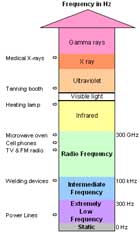
Electromagnetic Fields 2009 Update
Context - Safety limits have been set by the European Union for the protection of workers and the general public against the effects of mobile phones and other electromagnetic fields. Are these safety limits adequate in the light of recent scientific evidence?
The Scientific Committee on Emerging and Newly Identified Health Risks (SCENIHR) of the European Commission has updated its 2007 opinion on "Possible effects of Electromagnetic Fields (EMF) on Human Health", with respect to whether or not exposure to electromagnetic fields (EMF) is a cause of disease or other health effects.
- Introduction to electromagnetic fields
- Radio frequency fields like those from mobile phones and wireless devices
- What are the sources of exposure to radio frequency fields?
- Can mobile phones cause cancer?
- Can mobile phones or base stations trigger headaches or other health effects?
- Conclusions on mobile phones and radio frequency fields
- Electromagnetic fields generated by other devices
- Intermediate frequency fields like those from computer screens and anti-theft devices
- Extremely low frequency fields like those from power lines and household appliances
- Static magnetic fields like those used in medical imaging
- General issues and conclusions
- What is known about environmental effects of electromagnetic fields?
- Conclusions on electromagnetic fields
The answers to these questions are a faithful summary of the scientific opinion
produced in 2009 by the Scientific Committee on Emerging and Newly Identified
Health Risks (SCENIHR):
"Health Effects of exposure to Electromagnetic Fields (EMF)" Learn more...
1. Introduction to electromagnetic fields
1.1 Electromagnetic fields are a combination of invisible electric and magnetic fields of force. They are generated by natural phenomena, but also by human activities, mainly through the use of electricity.
Most man-made electromagnetic fields reverse their direction with time at a specific frequency, ranging from high radio frequencies (RF) – such as used by mobile phones – through intermediate frequencies (IF) – such as generated by computer screens – to extremely low frequencies (ELF) – such as generated by power lines.
The term static refers to fields that do not vary with time. Static magnetic fields are used in medical imaging and generated by appliances using direct current. More...
1.2 The present SCENIHR opinion uses the most recent scientific findings to assess whether exposure to electromagnetic fields may increase the risk of some adverse health effects. It considers both potential effects on groups of people who have been exposed to electromagnetic fields in their daily lives (epidemiological evidence) and potential effects observed in laboratory experiments carried out on human volunteers, animals, and cell cultures (experimental evidence). More...
2. What are the sources of exposure to radio frequency fields?

Local wireless computer networks generate radio fields
Credit: Ramzi Mashisho
Radio frequency (RF) fields have many applications in modern communications. Familiar sources include mobile phones, cordless phones, local wireless networks and radio transmission towers. Medical scanners, radar systems and microwave ovens also use RF fields. Radio frequencies range from 100 kHz to 300 GHz.
When exposed to RF fields, the body absorbs energy from them. Evaluating how much RF energy an individual absorbs every day is not obvious as the level of exposure depends on many factors, especially distance from the various sources and duration of exposure. Field strength or the amount of energy the field transmits, falls rapidly with distance, meaning a person may absorb more energy from a device used at close quarters – a handheld mobile phone, for example – than from a more powerful source, like a radio transmission tower, that is farther away. More...
2.1 The European Union has set safety limits on exposure to RF fields. For handheld mobile phones, these limits are given in terms of the energy absorbed by the head, the part of the body most exposed during use. Other wireless devices used in close quarters, like cordless phones and wireless computer networks, also generate radio waves but exposure from these sources is generally lower than from mobile phones. More...
2.2 Mobile phone base stations and radio transmission towers are structures designed to support antennas that transmit radio signals. Because the field strength decreases rapidly with distance, most people are exposed to only a fraction of the maximum recommended limit. People who live or work near transmission towers are most exposed because that is where the fields are strongest. More...
2.3 In medicine, strong RF fields are used to heat body tissue, which can ease pain or kill cancer cells. Such fields are also used to produce images of the brain and other body parts by magnetic resonance imaging (MRI). Exposure of patients or medical staff could exceed the usual safety limits for the general public. More...
3. Can mobile phones cause cancer?

More than 2 billion people use mobile phones worldwide
Credit: Juha Blomberg
3.1 In recent years many studies have investigated whether mobile phones and radio frequency (RF) fields in general could cause cancer. Epidemiological studies on mobile phone users have focused on cancers originating in the head, especially brain tumours. Overall, research indicates that mobile phone use does not increase the risk of cancer, especially when used for less than ten years. Findings from published studies in the ongoing Interphone project, which pools data from 13 countries, supports that finding. More research is needed to establish whether or not there is a risk associated with long term mobile phone usage well beyond ten years. More...
3.2 Animal studies that investigated if RF fields could induce cancer, enhance the effects of cancer-causing substances, or accelerate the development of tumours found no or no consistent effects when the study was repeated. Recent studies have used higher field strengths than previous ones, without any further effect. More...
3.3 Overall, research on how RF energy affects cells grown in the laboratory shows little evidence of health-relevant effects when exposure is below the one that causes a warming effect. Some studies suggest effects on DNA at exposure levels close to guideline limits, but there is little agreement between studies, and the significance of the effects observed remains unclear. More...
3.4 Few users have had mobile phones for more than ten years, which makes it difficult to investigate the cancer risk of longer term use.
Different biological effects have been investigated in cell cultures, but so far no mechanism that might lead to cancer could be found for radio frequency fields below the recommended safety limit for exposure from mobile phones. More...
4. Can mobile phones or base stations trigger headaches or other health effects?

Mobile phone base station
Credit: Pyb
4.1 Some people attribute headaches, fatigue and dizziness to radio frequency (RF) fields. Such complaints have raised concern that certain individuals may be more sensitive than others to electromagnetic fields.
Present knowledge suggests that these symptoms are not linked to exposure to radio frequency fields, but to a “nocebo” effect, an effect caused by the expectation or belief that something is harmful. More...
4.2 Because mobile phones are used near the head, there have been concerns they could affect the brain.
There is some evidence that radio frequency exposure might influence brain activity or sleep. However, the health relevance of these results is uncertain and how this may occur is not yet explained. Further investigation of these effects is needed. More...
4.3 Many studies on development and reproduction in animals have shown that radio frequency fields can cause birth defects at levels well above safety limits, when the exposure is high enough to warm up the tissue significantly, but not at lower exposure levels. Recent studies have looked into potential effects on the development of animals before birth and on the fertility of men who work near strong radio field sources. However, it is not possible to draw conclusions from these studies because of methodological limitations. More...
4.4 Few studies have addressed the possible effects of mobile phones on children, despite concern that children could be more vulnerable than adults because their nervous systems are still developing, their brain tissue is more conductive, and their heads might absorb more energy from mobile phones. Also, children who start using mobile phones will have a greater lifetime exposure than people who were adults when they began using mobile phones. More...
5. Conclusions on mobile phones and radio frequency fields

Few studies have looked at effects on children
Extensive research has been conducted in recent years on how radio frequency fields, including those generated by mobile phones, might affect health. A variety of possible effects has been studied, both inside the laboratory and among human populations.
Research indicates that a person who has used a mobile phone for up to 10 years does not have a higher risk of brain tumours or other cancers in the head. This also appears to be the case for someone who has used a mobile phone for more than 10 years, but few persons have used mobile phones for longer than 10 years.
Research has found no evidence that exposure to radio frequency fields at levels below existing safety guidelines could cause symptoms like headaches and dizziness. New data suggests the existence of a “nocebo” effect, an effect caused by the expectation or belief that something is harmful. Few studies have looked at possible health effects in children, despite the growing popularity of mobile phones among the young and concern that children might be more vulnerable because of their still developing nervous system. More...
6. Intermediate frequency fields like those from computer screens and anti-theft devices

Cathode ray tube screens generate intermediate frequency fields
Credit: Anissa Thompson
6.1 In this assessment, “intermediate” refers to frequencies ranging from 300 Hz to 100 kHz. These are lower than radio frequencies and higher than extremely low frequencies.
Technologies generating intermediate frequency fields have increased in recent years and include some anti-theft devices, induction hotplates, cathode ray tube screens and radio transmitters. Intermediate fields are also used by medical devices, and are generated by industrial processes such as welding. More...
6.2 Well-known biological effects in the intermediate frequency range are nerve stimulation at the lower end of the range and heating at the upper end of the range. Few data are available on the exposure of individuals to intermediate frequency fields and on possible health effects. Since a growing number of workers are exposed to intermediate frequency fields, it is important that research on possible health effects is given priority. More...
7. Extremely low frequency fields like those from power lines and household appliances

Power lines generate ELF fields Credit: Miguel Saavedra
7.1 Extremely low frequencies (ELF) are those below 300 Hz. Such fields are for instance generated by the alternating current (AC) used in most power lines, wiring and appliances. Other important sources of ELF fields are the generators used in power plants, welding machines, induction heaters as well as trains, trams and subway systems.
ELF fields have electric and magnetic components. ELF electric fields are particularly strong close to high voltage power lines, and ELF magnetic fields are particularly strong near induction furnaces and welding machines. More...
7.2 In the areas that are accessible to the public, exposure to extremely low frequency fields is below the set limits. When people pass directly below a high voltage power line, their level of exposure to such fields is relatively high, though still within safety limits. Low voltage power lines cause much lower exposure, and buried cables virtually none. At home, fields are strongest very near electric appliances such as vacuum cleaners, when in use.
Workers in the electric power industry and welders can be exposed to high levels of electromagnetic fields, and adequate safety measures are needed. Some medical applications also make use of extremely low frequency fields, for instance to stimulate bone growth, to treat pain, or to detect cancer. More...
7.3 There is some evidence that ELF magnetic fields can cause cancer in humans but it is far from conclusive. This was concluded based on studies indicating that children exposed to relatively strong ELF magnetic fields from power lines (although still well below safety limits) were more likely to develop leukaemia than those exposed to weaker fields. These results have not been confirmed or explained by experiments on animals and cell cultures. More...
7.4 No relation has been demonstrated between extremely low frequency fields and self-reported symptoms such as fatigue, headache, and concentration difficulties. For other suspected effects, there is a need for targeted laboratory studies on cell cultures to examine if and how extremely low frequency fields act on cellular components. More...
7.5 For some other diseases such as cardiovascular diseases, recent research indicates that a link to extremely low frequency fields is unlikely, but further study is needed on how they may affect the brain and spinal cord. More...
8. Static magnetic fields like those used in medical imaging

MRI scanners use static magnetic fields
Credit: Kasuga Huang
8.1 Static magnetic fields such as those generated by a permanent magnet do not vary over time, and as such do not have a frequency (0 Hz).
Man-made static magnetic fields are generated wherever electricity is used in the form of direct current (DC), for instance in some rail and subway systems, in aluminium production and in welding. In medicine, MRI (Magnetic Resonance Imaging) scanners use static magnetic fields to provide three-dimensional images of the brain and other body parts. In this application the exposure can exceed the usual recommended limit, both for the MRI operator and the patient. More...
8.2 Evidence is insufficient for drawing conclusions about potential health effects. Static magnetic fields can have an effect on biological molecules and cellular components with magnetic properties such as haemoglobin, and on those with electric properties like brain cells.
Data for risk assessment of static magnetic fields are still inadequate, and the effects of mixed fields, where static fields interact with other electromagnetic fields, are still largely unknown. A number of new technologies, such as MRI equipment, are using combinations of different fields, which makes this a priority for research. More...
9. What is known about environmental effects of electromagnetic fields?

Migratory birds rely on magnetic fields for orientation
Credit: Michael Hatherly
Field studies on individual animal and plant species living in close proximity to sources of electromagnetic fields provide information on possible effects on ecosystems.
Past field studies have mainly focused on wild birds and on potential effects on reproduction and orientation. Though some new study results have recently been published, overall, the current database is inadequate for the purposes of the assessment of possible risks due to environmental exposure to Radio, Intermediate and Extremely-low frequency fields. More...
9.1 Several studies indicate that exposure of wild birds to radio frequency fields can, under certain circumstances, lead to changes, for instance in behaviour, reproductive success, or growth and development. However, the changes observed are not consistent. A possible explanation of observed effects is that radio frequency fields discourage some bird species and encourage others or affect the insects they feed on. Other factors such as pollution might play a role. More...
9.2 The possible effects of extremely low frequency fields on reproduction have been studied in birds of prey living around overhead power lines, but findings vary widely, and no clear overall conclusion can be drawn. Afield study observed a reduction of the biological activity in the soil surrounding a buried electricity transmission cable, but the environmental significance of this finding is unclear.
Studies on plants have shown that ELF magnetic fields can promote the growth of certain plant species. More...
10. Conclusions on electromagnetic fields
10.1 There is no evidence that exposure to radio frequency fields through the use of mobile phones increases the risk of cancer when used for a period of up to 10 years, and data are still too limited to conclude on the use of mobile phones over longer periods. Self-reported symptoms like headaches, fatigue, or concentration difficulties have not been linked to exposure to radio frequency fields, but may be due to the individuals’ expectation that such exposure is harmful. Information on potential effects of radio-frequency fields on children is still limited. More...
10.2 Because data for the intermediate frequency fields are sparse, the assessment of health risks of short-term exposure to high levels of intermediate frequency fields is currently based on known biological effects at lower and higher frequencies. Proper assessment of possible health effects from long-term exposure is important because exposure to such fields is increasing, especially at certain workplaces, due to the use of new technologies. More...
10.3 The past conclusion that extremely low frequency magnetic fields are possibly carcinogenic is still valid. This was concluded based on studies indicating that children exposed to relatively strong magnetic fields from power lines were more likely to develop leukaemia. New studies on human populations indicate a possible increase in Alzheimer's disease arising from exposure to extremely low frequency fields. The results related to leukaemia and Alzheimer’s have not been confirmed or explained by experiments on animals and cell cultures. Further research on cells is needed to examine effects on specific diseases.
No consistent relationship between self-reported symptoms and extremely low frequency fields has been demonstrated. More...
10.4 New applications of strong static magnetic fields, used alone or in association with other fields, will require risk assessments for people who use these new technologies at work, as for instance operators of MRI scanners. More...
10.5 The data on how electromagnetic fields may affect animals and plants are insufficient to assess possible risks due to environmental exposure to radio frequency, intermediate frequency and extremely low frequency fields. More...
10.6 To fill the important gaps in knowledge, research efforts are recommended, notably on long- term exposure and effects on children and personnel dealing with equipment generating strong fields. More...
The Three-Level Structure used to communicate this SCENIHR Opinion is copyrighted by GreenFacts asbl/vzw.

